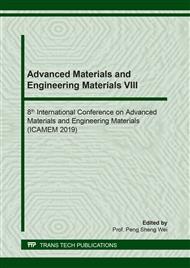[1]
Sun Y, Mayers B, Herricks T, et al. Polyol synthesis of uniform silver nanowires: a plausible growth mechanism and the supporting evidence[J]. Nano letters, 2003, 3(7): 955-960.
DOI: 10.1021/nl034312m
Google Scholar
[2]
Park J, Zheng H, Jun Y, et al. Hetero-epitaxial anion exchange yields single-crystalline hollow nanoparticles[J]. Journal of the American Chemical Society, 2009, 131(39): 13943-13945.
DOI: 10.1021/ja905732q
Google Scholar
[3]
Li L, Hu F, Xu D, et al. Metal ion redox potential plays an important role in high-yield synthesis of monodisperse silver nanoparticles[J]. Chemical Communications, 2012, 48(39): 4728-4730.
DOI: 10.1039/c2cc18152e
Google Scholar
[4]
Tan C, Zhang H. Epitaxial growth of hetero-nanostructures based on ultrathin two-dimensional nanosheets[J]. Journal of the American Chemical Society, 2015, 137(38): 12162-12174.
DOI: 10.1021/jacs.5b03590
Google Scholar
[5]
Li L, Chen Z, Hu Y, et al. Single-layer single-crystalline SnSe nanosheets[J]. Journal of the American Chemical Society, 2013, 135(4): 1213-1216.
DOI: 10.1021/ja3108017
Google Scholar
[6]
Fan Z, Luo Z, Huang X, et al. Synthesis of 4H/fcc noble multimetallic nanoribbons for electrocatalytic hydrogen evolution reaction[J]. Journal of the American Chemical Society, 2016, 138(4): 1414-1419.
DOI: 10.1021/jacs.5b12715
Google Scholar
[7]
Ma Y, Li W, Zeng J, et al. Synthesis of small silver nanocubes in a hydrophobic solvent by introducing oxidative etching with Fe (III) species[J]. Journal of Materials Chemistry, 2010, 20(18): 3586-3589.
DOI: 10.1039/c0jm00187b
Google Scholar
[8]
Pradhan N, Reifsnyder D, Xie R, et al. Surface ligand dynamics in growth of nanocrystals[J]. Journal of the American Chemical Society, 2007, 129(30): 9500-9509.
DOI: 10.1021/ja0725089
Google Scholar
[9]
Peng X, Wickham J, Alivisatos A P. Kinetics of II-VI and III-V colloidal semiconductor nanocrystal growth: focusing, of size distributions[J]. Journal of the American Chemical Society, 1998, 120(21): 5343-5344.
DOI: 10.1021/ja9805425
Google Scholar
[10]
Wang W, Goebl J, He L, et al. Epitaxial growth of shape-controlled Bi2Te3− Te heterogeneous nanostructures[J]. Journal of the American Chemical Society, 2010, 132(48): 17316-17324.
DOI: 10.1021/ja108186w
Google Scholar
[11]
Jin M, He G, Zhang H, et al. Shape‐controlled synthesis of copper nanocrystals in an aqueous solution with glucose as a reducing agent and hexadecylamine as a capping agent[J]. Angewandte Chemie International Edition, 2011, 50(45): 10560-10564.
DOI: 10.1002/anie.201105539
Google Scholar
[12]
Xiong Y, Xia Y. Shape‐controlled synthesis of metal nanostructures: the case of palladium[J]. Advanced Materials, 2007, 19(20): 3385-3391.
DOI: 10.1002/adma.200701301
Google Scholar
[13]
Li L, Hu F, Xu D, et al. Metal ion redox potential plays an important role in high-yield synthesis of monodisperse silver nanoparticles[J]. Chemical Communications, 2012, 48(39): 4728-4730.
DOI: 10.1039/c2cc18152e
Google Scholar
[14]
Sun Y, Yin Y, Mayers B T, et al. Uniform silver nanowires synthesis by reducing AgNO3 with ethylene glycol in the presence of seeds and poly (vinyl pyrrolidone)[J]. Chemistry of Materials, 2002, 14(11): 4736-4745.
DOI: 10.1021/cm020587b
Google Scholar
[15]
Wu Y, Wang D, Li Y. Nanocrystals from solutions: catalysts[J]. Chemical Society Reviews, 2014, 43(7): 2112-2124.
Google Scholar
[16]
Huang L, Zheng J, Huang L, et al. Controlled synthesis and flexible self-assembly of monodisperse Au@ semiconductor core/shell hetero-nanocrystals into diverse superstructures[J]. Chemistry of Materials, 2017, 29(5): 2355-2363.
DOI: 10.1021/acs.chemmater.7b00046.s001
Google Scholar
[17]
Shen S, Wang Q. Rational tuning the optical properties of metal sulfide nanocrystals and their applications[J]. Chemistry of Materials, 2012, 25(8): 1166-1178.
DOI: 10.1021/cm302482d
Google Scholar
[18]
Pradhan N, Peng X. Efficient and color-tunable Mn-doped ZnSe nanocrystal emitters: control of optical performance via greener synthetic chemistry[J]. Journal of the American Chemical Society, 2007, 129(11): 3339-3347.
DOI: 10.1021/ja068360v
Google Scholar
[19]
Peng Y, Wang L, Luo Q, et al. Molecular-level insight into how hydroxyl groups boost catalytic activity in CO2 hydrogenation into methanol[J]. Chem, 2018, 4(3): 613-625.
DOI: 10.1016/j.chempr.2018.01.019
Google Scholar
[20]
Kang Y, Yang P, Markovic N M, et al. Shaping electrocatalysis through tailored nanomaterials[J]. Nano Today, 2016, 11(5): 587-600.
DOI: 10.1016/j.nantod.2016.08.008
Google Scholar
[21]
Rycenga M, Cobley C M, Zeng J, et al. Controlling the synthesis and assembly of silver nanostructures for plasmonic applications[J]. Chemical reviews, 2011, 111(6): 3669-3712.
DOI: 10.1021/cr100275d
Google Scholar
[22]
Ji M, Xu M, Zhang W, et al. Structurally Well‐Defined Au@ Cu2− xS Core–Shell Nanocrystals for Improved Cancer Treatment Based on Enhanced Photothermal Efficiency[J]. Advanced Materials, 2016, 28(16): 3094-3101.
DOI: 10.1002/adma.201503201
Google Scholar
[23]
Liu C, Dasgupta N P, Yang P. Semiconductor nanowires for artificial photosynthesis[J]. Chemistry of Materials, 2013, 26(1): 415-422.
DOI: 10.1021/cm4023198
Google Scholar
[24]
Du G H, Chen Q, Han P D, et al. Potassium titanate nanowires: Structure, growth, and optical properties[J]. Physical Review B, 2003, 67(3): 035323.
Google Scholar
[25]
Wang B L, Chen Q, Wang R H, et al. Synthesis and characterization of K2Ti6O13 nanowires[J]. Chemical physics letters, 2003, 376(5-6): 726-731.
DOI: 10.1016/s0009-2614(03)01068-6
Google Scholar
[26]
Yoshida H, Takeuchi M, Sato M, et al. Potassium hexatitanate photocatalysts prepared by a flux method for water splitting[J]. Catalysis Today, 2014, 232: 158-164.
DOI: 10.1016/j.cattod.2013.10.046
Google Scholar
[27]
Bogicevic C, Thorner G, Karolak F, et al. Morphogenesis mechanisms in the solvothermal synthesis of BaTiO3 from titanate nanorods and nanotubes[J]. Nanoscale, 2015, 7(8): 3594-3603.
DOI: 10.1039/c4nr06266c
Google Scholar
[28]
Chao C, Ren Z, Yin S, et al. Hydrothermal synthesis of ferroelectric PbTiO3 nanoparticles with dominant {001} facets by titanate nanostructure[J]. CrystEngComm, 2013, 15(39): 8036-8040.
DOI: 10.1039/c3ce41248b
Google Scholar
[29]
Ogura S, Kohno M, Sato K, et al. Photocatalytic properties of M2Ti6O13 (M= Na, K, Rb, Cs) with rectangular tunnel and layer structures: Behavior of a surface radical produced by UV irradiation and photocatalytic activity for water decomposition[J]. Physical Chemistry Chemical Physics, 1999, 1(1): 179-183.
DOI: 10.1039/a806734a
Google Scholar


